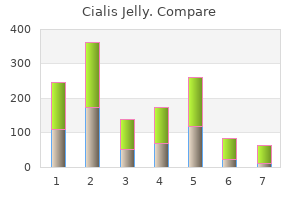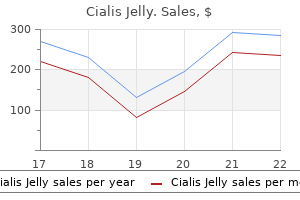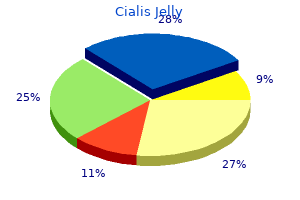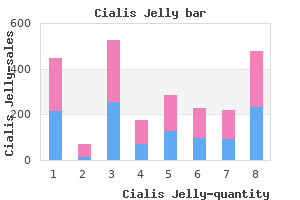Cialis Jelly

"Discount cialis jelly 20mg amex, strongest erectile dysfunction pills".
M. Ashton, M.B.A., M.B.B.S., M.H.S.
Professor, Louisiana State University School of Medicine in Shreveport
A stone was visualized and was entrapped in a basket and withdrawn under visual guidance erectile dysfunction in teens generic cialis jelly 20 mg line. For endoscopic procedures of the urethra erectile dysfunction remedies buy cheap cialis jelly 20mg line, refer to codes 52000-52700 drugs for erectile dysfunction in nigeria buy generic cialis jelly 20 mg line, which contain cystoscopy impotence in a sentence generic 20mg cialis jelly visa, urethroscopy, and cystourethroscopy procedures. If the physician performs the injection procedure for radiology studies for examination of the urethra, report 51600-51610 based on the type of study being performed. The radiological supervision and interpretation is reported separately with 74430 (cystography), 74450 (retrograde urethrocystography), or 74455 (voiding urethrocystography). A meatotomy is surgical incision of the meatus, which is the opening of the urethra to the outside of the body (urethral meatus). Codes 53020 (except infant) and 53025 (infant) report a meatotomy if it is performed as a separate procedure. Because 53025 is specifically for infants, do not append modifier -63 (Procedure performed on infants less than 4 kg). When infected, the gland will become enlarged and tender and may require drainage or excision. The Excision category of codes (53200-53275) includes services such as biopsy, urethrectomy, lesion excision, fulguration, and marsupialization (creating a pouch). When the urethra is totally surgically removed (urethrectomy), the service is reported with 53210 for a female and 53215 for a male. A urethrectomy involves removal of the urethra and creation of an opening from the bladder to the skin that is then used to drain urine. These glands secrete a fluid that forms part of the semen and drains directly into the urethra. The choice of codes to report a urethroplasty is based on the number of stages and type of repair. Codes 53420 (first stage) and 53425 (second stage) report the two stages of an urethroplasty, and 53415 reports a one-stage urethroplasty. An artificial sphincter is inflatable and includes a pump, reservoir, and cuff, is inserted through a subpubic incision, and is illustrated in. The small switch in the scrotum can be manipulated to activate the pump and control urinary continence. Urethromeatoplasty is repair of the meatus and the urethra (53450, 53460) and is performed to open and/or reconstruct the urethra. The Manipulation category codes (53600-53665) are a bit different from those you have encountered previously. The Dilation codes are based on initial or subsequent dilation of a male or female patient. The greatest number of category codes are under the subheading Penis because there are many repair codes in this subheading. The other subheadings are primarily for incision and excision, with only a few repair codes for the remaining subheadings. Under the Incision category (54000-54015) of the subheading Penis, there is an incision and drainage code (54015). Recall that under the Integumentary System section there are incision and drainage codes. The code from the Penis subheading is for a deep incision, not just an abscess of the skin. For the deep abscess described in 54015, the area is anesthetized, the abscess is opened and cleaned, and often a drain is placed to maintain adequate drainage. Under the Destruction category (54050-54065) of the subheading Penis there are also destruction codes for lesions of the penis. These lesion destruction codes are divided on the basis of whether the destruction is simple or extensive. The code for extensive lesion destruction can be reported no matter which method was employed to accomplish the extensive destruction. Excision codes (54100-54164) include codes to report biopsy of the penis (54100, 54105). Note that 54100 has a designation of "separate procedure," which means that the code is reported when the biopsy was the only procedure performed during the operative session. To accomplish the biopsy, the physician removes a portion of a lesion by excision of a small section of the lesion (scalpel or scissors) or by a punch biopsy.

Fluorescent dyes most commonly conjugated to 520 Chapter 8 Molecular Diagnostics 34 erectile dysfunction at the age of 25 cheap cialis jelly 20mg without a prescription. Typically erectile dysfunction treatment in singapore trusted 20mg cialis jelly, a panel of 12 or more antibodies is used to characterize the lineage and maturity of a cell population erectile dysfunction drugs medications buy 20 mg cialis jelly with mastercard. The lysate was diluted 1:100 and its absorbance measured in an ultraviolet spectrophotometer at 260 nm and 280 nm ketoconazole impotence cialis jelly 20mg for sale. An absorbance maximum for protein is 280 nm owing to the phenolic rings of tyrosine and tryptophan. When many mutations of a gene are possible, the most widely used detection method is sequencing. When a fluorescent-labeled nucleotide is added a laser determines its emission and the base is identified. The blocking group and fluorescent dye are removed and the process repeated for the next base added. Analogous to the genome, the proteome is the totality of proteins present within a cell or organism. Proteomic studies are aimed mainly at identifying protein signatures for various cancers. Serum is analyzed by time-of-flight mass spectroscopy and thousands of proteins are matched to identify those that can discriminate between cancerous and normal cells. A commercially available test based on proteomics is available for differentiating malignant from benign ovarian tumors. A level of maternal contamination below 1% does not guarantee accuracy, but misinterpretation due to maternal contamination is unlikely. Negative genetic tests can be reported, but positive results should be confirmed using cultured cells. K-Ras is a tumor suppressor gene and mutations are associated with increased lifetime risk of malignancy C. K-Ras mutations result in treatment resistance to growth factor receptor inhibitors D. A comparison of methods for the determination of alkaline phosphatase is categorized in which domain of educational objectives Behavioral Education and management/Apply knowledge of educational methodology/1 domain of educational objectives C the cognitive domain of educational objectives deals with application, analysis, synthesis, and evaluation of information or knowledge learned to be utilized in problem solving. B the affective domain of educational objectives includes those that emphasize values, attitudes, and interests that attach a worth to an activity, situation, or phenomenon. A A criterion-referenced test is used to determine the mastery of predetermined competencies, while a norm-referenced test evaluates students by comparison to the group. Accuracy of a test Education and management/Apply knowledge of educational testing/1 523 524 Chapter 9 Education and Management 4. An instructor "curved" a blood bank exam given to medical laboratory science students. Criterion referenced Education and management/Apply knowledge of educational testing/2 laboratory science student is to perform calibration, plot data, and evaluate the acceptability of controls. All of these options Education and management/Apply knowledge of educational methodology/3 8.

This involves recentrifuging the tube erectile dysfunction protocol ingredients best 20mg cialis jelly, then withdrawing serum and replacing it with 2 drops of saline erectile dysfunction treatment california 20 mg cialis jelly mastercard. All of these options Blood bank/Apply principles of basic laboratory procedures/Compatibility/1 23 erectile dysfunction and diabetes pdf buy generic cialis jelly 20 mg on line. B For transfusion of platelets and plasma impotence drug buy discount cialis jelly 20 mg online, there is no required protocol for crossmatching. Although all choices would be compatible, the first choice should be A-positive because this unit will contain residual plasma anti-B. Anti-B is less immunogenic than anti-A, which would be present, albeit in small amounts, in B-positive and O-positive units. B the abbreviated crossmatch usually consists of a type and screen and an immediate spin crossmatch. When there is no history of antibodies and the current antibody screen is negative C. When a patient has not been transfused in the past 3 months Blood bank/Apply principles of basic laboratory procedures/Crossmatch/1 4. The medical laboratory scientist began the laboratory investigation of the transfusion reaction by assembling pre- and post-transfusion specimens and all paperwork and computer printouts. Perform an antibody screen on the posttransfusion sample Blood bank/Apply knowledge of standard operating procedures/Transfusion reactions/2 anaphylactic and anaphylactoid reactions Donor plasma has reagins (IgE or IgA) that combine with allergens in patient plasma C. Patient is deficient in IgE and develops IgE antibodies via sensitization from transfusion or pregnancy D. Patient is deficient in IgA and develops IgA antibodies via sensitization from transfusion or pregnancy Blood bank/Apply knowledge of fundamental biological principles/Transfusion reactions/1 4. The most time-saving approach would be to check all paperwork before performing any laboratory testing. D Anaphylactic or anaphylactoid reactions are the most severe form of allergic transfusion reaction and are associated with deficient or absent IgA in the patients, allowing them the capability to form antiIgA. These patients must be transfused with washed cellular products where the plasma has been removed. B A transfusion reaction that occurs several days after a transfusion of blood products is probably a delayed immunologic reaction due to an antibody formed against donor antigens. Transfusion-related acute lung injury Blood bank/Apply knowledge of fundamental biological characteristics/Transfusion reactions/1 to an O patient Febrile nonhemolytic transfusion reaction Blood bank/Apply knowledge of fundamental biological characteristics/Transfusion reactions/2 9. During the transfusion, her pulse was 94, and blood pressure rose from 114/59 to 132/64. Delayed hemolytic Blood bank/Correlation of laboratory and clinical data/Transfusion reactions/3 red cells 2 days ago. An antibody screen and panel studies revealed the presence of anti-Jkb (postspecimen). The recipient cells were likely positive for the Jkb antigen Blood bank/Apply knowledge of fundamental biological characteristics/Transfusion reactions/3 evaluation of a transfusion reaction, except: A. B Group A blood given to a group O patient would cause an immediate hemolytic transfusion reaction because a group O patient has anti-A and anti-B antibodies and would destroy A cells. C this is an example of an anamnestic reaction where the patient was most likely exposed to the Jkb antigen at some point in his life, and upon re-exposure to the antigen, the antibody titer rose to detectable levels. A febrile nonhemolytic reaction is highly consistent with both symptoms and posttransfusion test results. A 92-year-old male diagnosed with anemia 147 and episodes of frequent falling was typed as B negative and transfused 1 unit of packed red blood cells, also B negative. Volume overload Blood bank/Correlation of laboratory and clinical data/Transfusion reaction/3 transfused 2 units of packed red blood cells.

Therapeutically erectile dysfunction interesting facts generic 20 mg cialis jelly overnight delivery, it is done to relieve pain impotence journal cialis jelly 20 mg cheap, dyspnea erectile dysfunction medication uk generic cialis jelly 20 mg without prescription, and other symptoms of pleural pressure erectile dysfunction at age of 20 cheap 20 mg cialis jelly with visa. Diagnostically, thoracentesis is performed to obtain and analyze fluid to determine the etiology of the pleural effusion. Transudates are most frequently caused by congestive heart failure, cirrhosis, nephrotic syndrome, and hypoproteinemia. Exudates are most often found in inflammatory, infectious, or neoplastic conditions. However, collagen vascular disease, pulmonary infarction, trauma, and drug hypersensitivity also may cause an exudative effusion. Gross appearance the color, optical density, and viscosity are noted as the pleural fluid appears in the aspirating syringe. A needle is placed through the chest wall and into the fluid contained in the pleural cavity. A special one-way valve system is placed between the needle and the syringe to allow aspiration of fluid when the plunger of the syringe is pulled back and diversion of the fluid to a container when the plunger is pushed in. An opalescent, pearly fluid is characteristic of chylothorax (chyle in the pleural cavity). The predominance of polymorphonuclear leukocytes usually is an indication of an acute inflammatory condition. Protein content Total protein levels greater than 3 g/dL are characteristic of exudates, whereas transudates usually have a protein content of less than 3 g/dL. The albumin gradient between serum and pleural fluid can differentiate better between the transudate and thoracentesis and pleural fluid analysis 885 exudate natures of pleural fluid than can the total protein content. This gradient is obtained by subtracting the pleural albumin value from the serum albumin value. The total protein ratio (fluid/serum) has been considered to be another accurate criterion differentiating transudate from exudate. An exudate is identified with a high degree of accuracy if the pleural fluid/serum protein ratio is greater than 0. Low values appear to be a combination of glycolysis by the extra cells and impairment of glucose diffusion because of damage to the pleural membrane. Values less than 60 mg/dL are occasionally seen in tuberculosis or malignancy and typically occur in rheumatoid arthritis and empyema. Amylase levels above the normal range for serum or two times the serum level are seen when the effusion is caused by pancreatitis or rupture of the esophagus associated with leakage of salivary amylase. Triglyceride Measurement of triglyceride levels is an important part of identifying chylous effusions. These effusions are usually produced by obstruction or transection of the lymphatic system caused by lymphoma, neoplasm, trauma, or recent surgery. Gram stain and bacteriologic culture these tests are routinely performed when bacterial pneumonia or empyema is a possible cause of the effusion. Cultures for Mycobacterium tuberculosis and fungus Tuberculosis is less often a cause for pleural effusion in the United States today than it was. Fungus may be a cause of 886 thoracentesis and pleural fluid analysis pulmonary effusion in patients with compromised immunologic defenses. Cytology A cytologic study is performed to detect tumor cells in patients with malignant effusions. Inform the patient that movement or coughing should be minimized to avoid inadvertent needle damage to the lung or pleura during the procedure. The patient is usually placed in an upright position, with the arms and shoulders raised and supported on a padded overhead table. This position spreads the ribs and enlarges the intercostal space for insertion of the needle. Patients who cannot sit upright are placed in a side-lying position on the unaffected side, with the side to be tapped uppermost. The needle insertion site, which is determined by percussion, auscultation, and examination of a chest x-ray image, ultrasound scan, or fluoroscopy, is aseptically cleansed and anesthetized locally. The needle is positioned in the pleural space, and the fluid is withdrawn with a syringe and a three-way stopcock. Various mechanisms to stabilize the pleural needle are available to secure the needle depth during the fluid collection.

All cultures should be performed before antibiotic therapy is initiated; otherwise the antibiotic may interrupt the growth of the organism in the laboratory erectile dysfunction recovery buy cialis jelly 20mg with amex. Most organisms require approximately 24 hours to grow in the laboratory erectile dysfunction gel treatment discount 20 mg cialis jelly with visa, and a preliminary report can be given at that time erectile dysfunction young male causes cheap 20mg cialis jelly with visa. Cultures may be repeated after appropriate antibiotic therapy to assess for complete resolution of the infection how erectile dysfunction pills work discount cialis jelly 20mg line. To save money, urine cultures are usually done only if the urinalysis suggests a possible infection. One half is sent for urinalysis; the other is held in the laboratory refrigerator and evaluated only if the urinalysis indicates a possible infection. An important part of any routine culture is to assess the sensitivity of any bacteria that are growing in the urine to various antibiotics. The physician can then more appropriately recommend the correct antibiotic therapy. Procedure and patient care Before Explain to the patient the procedure for obtaining a cleancatch (midstream) urine collection. This requires meticulous cleansing of the urinary meatus with an antiseptic preparation to reduce contamination of the specimen by external organisms. Then the cleansing agent must be completely removed or it will contaminate the urine specimen. Having the patient begin to urinate in a bedpan, urinal, or toilet and then stop urinating (this washes the urine out of the distal urethra) 2. Correctly positioning a sterile urine container, into which the patient voids 3 to 4 ounces of urine 3. The abdomen is prepared with an antiseptic, and a 25-gauge needle is inserted into the suprapubic area 1 inch above the symphysis pubis. Urine is aspirated into the syringe and then transferred to a sterile urine container. This test is indicated to investigate dysfunctional voiding or suspicious outflow tract obstruction. It is also done before and after any procedure designed to modify the function of the urologic outflow tract. The flow rates are the highest and most predictable in the urine volume range of 200 mL to 400 mL. When the bladder contains more than 400 mL of urine, the efficiency of the bladder muscle is greatly decreased. If the flow rates are abnormally low, the test should be repeated to check for accuracy. If flowmeters are not available, the patient can time the urinary stream with a stopwatch and record the voided volume; from this, the average flow is calculated. In some cases it is more valuable to analyze several voided volumes and flow rates rather than a single flow rate. Together with clinical observation, this provides very valuable information on the severity of outflow obstruction, the likelihood of urinary retention, and the state of compensation or decompensation of the detrusor muscle. Abnormal findings Dysfunctional voiding Urethral stricture Prostate cancer Prostatic hypertrophy notes U 972 uroporphyrinogen-1-synthase uroporphyrinogen-1-synthase Type of test Blood Normal findings 1. This group of disorders results from enzymatic deficiencies in synthesis of heme (a part of hemoglobin). The acute phase is highlighted by symptoms of abdominal and muscular pain, nausea, vomiting, hypertension, mental confusion, sensory loss, and hemolysis. This enzyme is significantly reduced during the acute and latent phases of this disorder. Because this test is based on the hemoglobin measurement, concurrently obtain a hemoglobin level on the patient. A pheochromocytoma is a tumor of the chromaffin cells within the adrenal medulla that frequently secretes abnormally high levels of epinephrine and norepinephrine.
